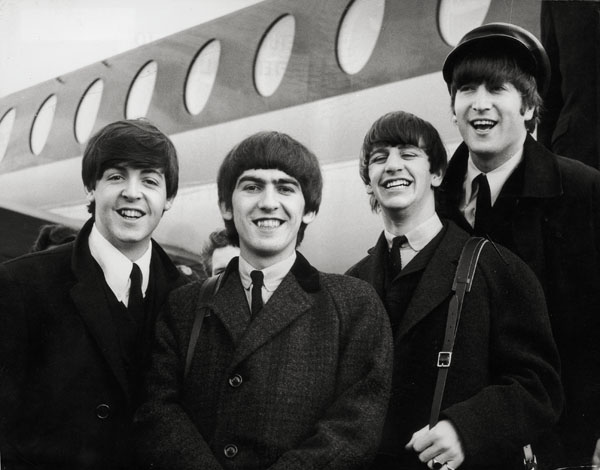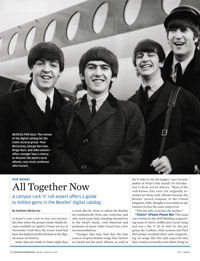In Review
 BEATLES FOR SALE: The release of the digital catalog for the iconic musical group—Paul McCartney, George Harrison, Ringo Starr, and John Lennon—offers younger fans a chance to discover the band’s early albums, says music professor John Covach. (Photo: Getty Images)
BEATLES FOR SALE: The release of the digital catalog for the iconic musical group—Paul McCartney, George Harrison, Ringo Starr, and John Lennon—offers younger fans a chance to discover the band’s early albums, says music professor John Covach. (Photo: Getty Images)It wasn’t just a day in the life for Beatles fans when the group’s music finally became available on Apple’s iTunes service in November. Until then the iconic band had been the highest profile holdout in the digital music revolution.
Some fans are ready to listen eight days a week. But for those to whom the Beatles are emphatically from, um, yesterday, and who need some help orienting themselves to the band’s music, rock historian and professor of music John Covach has a few recommendations.
“Younger fans may find that the best sources of great Beatles songs they haven’t yet heard are the early albums, as well as the b-sides to the hit singles,” says Covach, author of What’s that Sound? An Introduction to Rock and Its History. “Most of the well-known hits were not originally included on these early albums because the Beatles’ record company in the United Kingdom, EMI, thought it was unfair to ask listeners to buy the same song twice.
“This list only scratches the surface.”
“Chains” (Please Please Me) This song was written by the Brill Building songwriting team of Gerry Goffin and Carole King and was a No. 17 hit in 1962 for the girl group the Cookies. John Lennon and Paul McCartney modeled their early songwriting on songs like this and expected that they would eventually earn their living in the music business mostly as songwriters. On their first visit to the United States in 1964, John and Paul reportedly were hoping to meet King.
“Words of Love” (Beatles for Sale) The original Buddy Holly version of this song features Buddy’s voice and guitar double-tracked to produce two vocal parts and a shimmering guitar sound. The Beatles provide a very close copy of that record, with John Lennon and George Harrison providing harmony vocal, backed up by George’s guitar.
“You’re Gonna Lose That Girl” (Help!) A great track that highlights the influence of early–’60s rhythm and blues on the Beatles’ songwriting and performance style. You can easily imagine this tune being sung by the Drifters or the Temptations.
“The Inner Light” (b-side to the single “Lady Madonna”) This George Harrison–penned song highlights the guitarist’s engagement with Eastern philosophy and religion. The opening lyric is lifted directly from the Tao Te Ching.
“You Know My Name (Look Up the Number)” (b-side to the single “Let It Be”) As serious as the Beatles were about their music, they often tempered particularly serious moments with their trademark humor. Sgt. Pepper ends with the inner-groove loop music, which follows the epic “A Day in the Life,” while Abbey Road features cheeky “Her Majesty” directly after “The End.” Most of the comical “You Know My Name” was recorded in the summer of 1967 and later released as the flip side to one of the band’s farewell hit singles.
And for those who become devoted enough Beatles fans to seek out music not yet on iTunes, Covach thinks you’ll thank him very much for this suggestion:
“That’s All Right (Mama)” (Live at the BBC) Recorded for the BBC in the summer of 1963, this is a carefully crafted imitation of the Elvis Presley version of this song, with Paul doing a very convincing Elvis and George copping all the Scotty Moore licks on the guitar.

